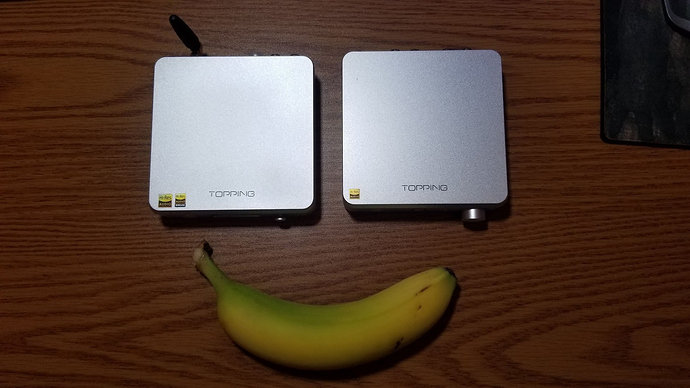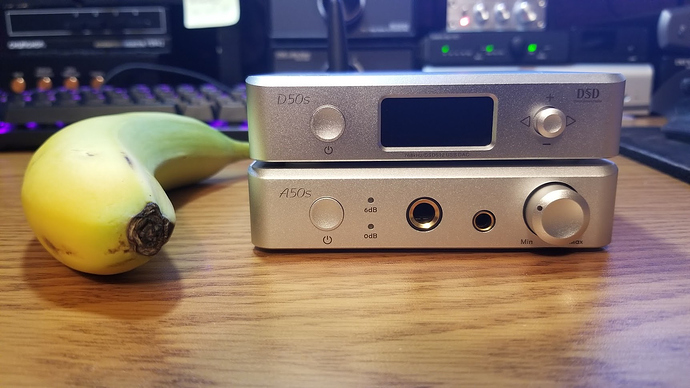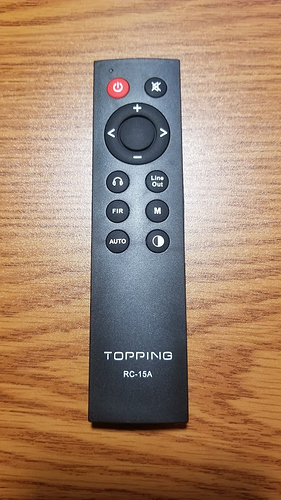INTRODUCTION
Apos Audio graciously loaned me the Topping 50 stack, both the A50s headphone amplifier and the D50s DAC. Here we dig into the DAC. Neither Apos nor Topping attempted to influence my opinion on this review and the opinions expressed below are my own.
TL;DR
The Topping D50s is a clean, detailed DAC with a somewhat narrow soundstage and some treble sharpness. It doesn’t quite measure up with similarly priced DACs for pure sound quality but it does come with some features – such as a remote control, digital filters, and Bluetooth connectivity with LDAC – and customizability – through op-amp swapping – all in a tiny, well-built package that make it a solid options for those who are not treble sensitive and like to tinker.
WAIT, AREN’T WE MAD AT TOPPING?
Topping has been in the audio news lately – such as it is – for inauspicious reasons. I won’t go into details here but you can read about the issue further here. Given that the D50s is a DAC there is essentially 0 chance that it failing would damage a headphone. In fact, I don’t think I’ve ever heard of such a thing. However, it is true that Topping’s customer service through the L30 episode was sub-par. I therefore do this review that so you as a potential buyer can go into considering a Topping product with fully informed consent.
FEATURES & BUILD
The D50s is a single-ended digital-to-analog converter (DAC). It lists for $249.99 USD. Decoding options include PCM up to 32-bit/768KHz and DSD up to DSD512. It has 7 digital EQ filters, has Bluetooth connectivity with AptX and LDAC codecs, and 3 digital audio inputs. The D50s is a delta-sigma DAC that uses an ESS Sabre chip to do the actual conversion of digital to analog. It also has an included remote control.
The D50s comes in a small, square, metal chassis that is very sturdy and well made. The footprint of this chassis is remarkably small. Take a look:
(On the right and bottom of these pics is the matching A50s amp)
This metal chassis is also quite heavy for its size. The back panel sports a 5V DC power socket (a USB-to-DC power cord is included in the package), a threaded terminal for Bluetooth antenna (also included), a full-size USB 2.0 port, Toslink optical input, RCA coaxial spdif input, and R/L RCA stereo analog outputs. The front panel has small, monochrome LED screen that indicates input selection, sample rate, and provides a UI for the menu system. There’s also a power button and a 4-way joystick to help navigate the menu. I found this joystick a bit of a challenge to use. It recognizes pushes left, right, up, and down, and it can be pushed to select. However, the stick is very small and can be pushed in any direction. I had numerous moments of things like trying to push the stick right and the menu navigated up. I eventually gave up on it and used the include remote control, which is much easier.
Let’s talk about feet! I mentioned this in my A50s review too but I like this feature and think it’s worth mentioning here too. The bottom of the D50s has four rubber feet that are quite sticky. It is very difficult to get this little unit to slide across a desktop. I like this. I’ve had numerous light, small form-factor devices where a stiff wire pushed it around or a wire that hung off the edge of the desk pulled it out of place. That doesn’t really happen with the D50s. I applaud Topping for this simple yet effective ergonomic feature.
About that remote control. If you’ve ever had a Topping or SMSL product with remote you’ll recognize this one:
The remote controls all the major functions and does so more elegantly that the front-panel joystick. The remote requires AAA batteries that are not included, so have some on hand. The remote has a handy ‘Line Out’ button on it too to switch between the D50s’ analog output being a preamp output or a line-level output.
I’ll mention here, although I did not test this and it’s not something I have ever done, that there is an op-amp rolling possibility with the D50s. There are 4 screws in the bottom of the unit that exposes the innards. I won’t go into that here because this is not a thing that is of interest to me, and I never opened this review unit. However, various users around the internet report changes to the sound quality with different op-amps. This option might be intriguing for those who enjoy this kind of modding.
SOUND
Overall, the sound of the D50s is clean, detailed, and reasonably dynamic. The soundstage is narrower than some other DACs I’ve heard in the price range but the imaging is reasonably tight and precise. The treble isn’t elevated but does fall prey to the “ESS esses.” There is an above-average amount of sibilance fairly often when vocalists use ‘s’ and ‘t’ sounds. Detail retrieval is solid, though. Things like room reverb were resolved well and realistically. The bass is punchy with decent slam. I detected some occasional grain in the lower treble and upper midrange, however. The sound quality overall strikes me as solid, but not class-leading. Bottom line on sound to me is the D50s isn’t particularly remarkable toward the good or bad sonically. It has some issues (the sibilance, narrow soundstage – that one is more preference, and mid-range grain) and it has some strengths (cleanliness, detail retrieval, imaging), but neither the strengths nor the weaknesses are particularly strong or weak. TBH, the sound is just-kinda-there. To me that’s neither praise nor critique. There will be many listeners who will appreciate that the D50s’ sound doesn’t announce itself all that much. There will be just as many listeners who will wish it has a bit more character.
I will comment briefly on the digital filters. There are 7 filter settings. The first is the standard ‘no filter’ which leaves 6 slightly modified modes. The first 3 of these filters mostly pushed the mid-range more forward a little bit more with each number of filter up. However, after the third one I really couldn’t tell much anymore what they were doing.
And how ‘bout that Bluetooth? Even with the LDAC enabled (using a Samsung Galaxy Note 8 smartphone) the overall level of detail and sound quality wasn’t quite up to the level that the USB or spdif inputs could produce. Bluetooth is much improved but it’s not quite there, yet. Even so, the lossy nature of Bluetooth transmission actually helped out the D50s to a degree. The treble sharpness was not as prevalent from the Bluetooth. The timbre wasn’t as good, the resolution wasn’t as good, and the sound had a more ‘digital’ flavor to it, for lack of better term, but the sibilance was less distracting. Even so, the sound certainly was not bad and was quite enjoyable when I was not listening critically. I think the inclusion of Bluetooth is a nice feature for when the listener is casually listening and extra wires get in the way.
AMP PAIRINGS
The natural pairing with the D50s is its aesthetic match the A50s. I however do not like this pairing. The A50s smooths out the overall sound too much for my liking but also does not rein in the D50s’ ESS treble; it exacerbates it. I got the best results out of the D50s when it was paired with amps that are bit more controlled and smoother in the treble. The Schiit Magnius increased some control of that treble – although did not eliminate all the sharpness – and also widened the soundstage back out a bit. The Schiit Asgard 3 reined in the treble even more and widened the soundstage even more than the Magnius did. I also thought the D50s was a decent complement to my Cayin HA-1AMK2 tube amp. The brighter and more detail-forward presentation of the D50s complemented the 1AMK2’s smoothness and slight treble roll-off well, especially with hi-impedance headphones like the Massdrop + Sennheiser HD6XX and the 1AMK2 set to a higher output impedance.
COMPARISON WITH OTHER DACS
My reference budget DAC right now is the Schiit Modius ($199). The Modius bests the D50s on soundstage width, has more natural timbre, has an overall smoother sound, and is far less sibilant. Within their respective soundstages they image with about the same level of proficiency. I’m on the fence if one is more detailed than the other. If pressed I’d describe the Modius as being the one that’s just slightly more resolving but that the D50’s brighter presentation can be perceived as being more detailed. For me the D50s is not displacing the Modius as my reference budget DAC because of its treble sharpness and the fact that it sounds overall more sterile and less engaging than the Modius. Both DACs measure very well in frequency response, distortion, and noise measurements, though. The Modius is a balanced DAC and I think it is slightly better sounding from its balanced output than its SE output, but even from its SE output I have a personal preference for its sound.
I had the Topping E30 DAC in for review a couple months ago. The D50s has more features (additional filter options, Bluetooth) and is ESS chip based where the E30 is AKM chip based. It’s been awhile but I recall the E30 being a bit smoother sounding but the D50s being more detailed. The overall sound quality is close though. It’s up to the end user whether the D50s Bluetooth connectivity and increased customizability are worth the extra $120 the D50s costs over the E30.
I owned the SMSL SU-8 and used it as my primary DAC for a long time and it can still be found for the same price as the D50s. The SU-8 is also an ESS DAC but has balanced outputs and several more digital filters than the D50s. If the amplifier used has only RCA inputs, I think the D50s sounds superior as the SU-8 is a bit mid-forward and slightly grainier in the midrange than the D50s. However, I prefer the sound from the SU-8 if its balanced outputs are used. Both the SU-8 and D50s are very clean with good detail retrieval for the price, but the balanced output of the SU-8 has a wider soundstage. I also like that the SU-8 has PCM filters that smooth out its sound some in comparison to the D50s.
FINAL THOUGHTS
My general sense with using the Topping D50s is that it’s alright. To me it neither stands out as being a price/performance champion nor as being a product to outright avoid. IMO for pure sound quality there are better options in the price range. I think the D50s is suited to listeners who are not treble sensitive, don’t prioritize a big soundstage, have limited desk space, and are drawn to its modding potential. To my ear the sound quality improvement and Bluetooth connectivity is not enough to warrant buying the D50s over its cheaper sibling model the E30 mated with Topping’s BC3 Bluetooth receiver. Together those two devices cost $200 and provide almost all the features the D50s brings. Yes, the combo comes with some added complexity because it’s 2 small boxes instead of 1, but that’s what I would do.
Once again, thank you all for reading another one of my long, detailed reviews. And as always, enjoy the music! 




 So topping here wins by availability. Shiit in other areas.
So topping here wins by availability. Shiit in other areas. Good brand you have
Good brand you have